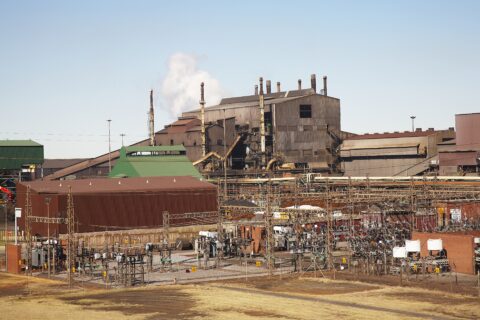SA Mining
How COP26 Agreements May Affect SA’s Coal Mining Industry
By: Benjamin van der Veen.
The United Nations Climate Change Conference (COP26), all a part of the UN Framework Convention on Climate Change (UNFCCC), took place in Glasgow, UK, in November last year.
Many had high hopes for COP26 to finally provide concrete answers and actionable plans, where nations would take accountability and come to an agreement to ensure the original Paris Agreement formed at the COP21 in 2015 was kept – or was at least on target to being fulfilled.
However, many green activists and nations were left with a bitter taste after the conference. South Africa’s coal mining industry in particular may have a lot to say on some of the agreements delegates committed to fulfilling.
COP26’s aims and agreements
COP26 saw many debates, initiatives and speeches concerning how the UNFCCC should approach the goals set out in the Paris Agreement, and solutions to further decrease the effects of global warming by phasing out the use of inefficient fossil fuels. Countries in attendance were asked to present their 2030 emission reduction targets aligned with reaching net-zero by 2050.
Nations will have to begin accelerating the phasing out of coal, install measures to prevent deforestation, invest in renewable energy and renewable energy research and development, and accelerate the switch to electric vehicles.
COP26 is the first time there has been a clear plan to reduce the use of coal.
The agreement – known as the Glasgow Agreement – was initially created around phasing out the production and use of coal entirely by 2030. However, a last-minute secret meeting that took place between the United States, Chinese and Indian governments saw the wording of the agreement changed to “phase down” (lower the total use) instead of “phase out”.
Developed nations pledged to significantly increase money to help developing countries deal with making the switch to clean and renewable energy and the adverse effects of climate change. South Africa and other developing nations were happy to be told that the $100-billion in incentives promised during the 2009 COP event in Copenhagen would be fully paid out by 2025. Developing countries were also offered the prospect of a trillion-dollar-a-year fund from 2025.
Coal mining and consumption
To further understand all that happened at COP26 in securing a global net-zero future and South Africa’s coal mining industry, SA Mining spoke to Minnette Le Roux, a principal environmental specialist and head of the environmental department at NSDV.
“Severe impacts of global warming at 2°C have become clear, rather than the Paris limit of 1.5°C warming. Some major highlights of the COP26 are to keep the goal of 1.5°C warming alive by implementing greater actions and taking immediate steps to reduce global emissions.
“It is also the first COP where the decision was taken to explicitly target action against fossil fuels, calling for a ‘phase down’ of ‘unabated coal’ and ‘phase out’ of ‘inefficient’ fossil fuel subsidies.”
Le Roux further explains that for South Africa to reach the agreements and goals set out, SA’s coal mining sector would have to take certain steps. “The South African coal mining sector would need to adapt.
“This can be seen in the recent Mine Closure Strategy under public and stakeholder consultation. This strategy includes a drive for closure of mines to be at least carbon-neutral and for mines to implement carbon-negative plans via sequestrating or offsetting.”
Alternative energy – a solution?
In 2019 South African coal mines produced 258.9 million metric tonnes of coal, equivalent to sales of R139.3-billion. During the same period, the coal mining industry employed 92 230 people, representing roughly 19% of the total employment within South Africa’s mining sector.
Therefore, the news of South Africa’s acquiescence to the Glasgow Agreement at COP26 has led to concern within the coal sector.
When asked about renewable energy alternatives as a possible solution to South Africa’s coal problem, Nicolas Marsay, an independent specialist in broad-based black economic empowerment, economic development and localisation, said: “Renewable energy, combined with storage and smart grids, is a viable alternative. However, South Africa can further explore utilising more efficient coal power generation technology while reclaiming existing coal waste dumps by using new extraction technologies.
“Whereas green hydrogen has game-changing potential, significant research and development investment is required to bring pricing down to be economically viable. Thorium-based nuclear power is an excellent medium to a long-term alternative too.”
The use of carbon-neutral, more efficient coal power generation and rehabilitation planning seems to be the best short-term alternative for South Africa’s coal mining sector. However, the effectiveness of specific renewable energy sources such as solar energy is entirely dependent on the geography of the power plant.
Renewable energy companies and mining companies alike will have to make sure that they research the correct locations for these renewable energy sources to be used to their maximum potential.
Coal mining companies Exxaro and Seriti Resources, which supply the state-owned power utility Eskom with over 80% of its annual coal supply, have already begun shutting down and transforming their closed mines and available properties into renewable energy farms.
Eskom, Exxaro and Seriti Resources all stated when signing the memorandum of understanding (MOU) between them that the pursuit of this project would create upskilling opportunities for local mine communities situated around their mining operations and additional employment opportunities. It would also allow South Africa to take a step towards a transition to a low-carbon future.
The signing of the MOU is a massive step in the right direction concerning upskilling, retention, and the addition of labour within the coal sector.
The memorandum also puts South Africa in a better position to fulfil its goals in the Paris and Glasgow agreements and allows for a more effortless switch to renewable energy.







 Sign-up and receive the Business Media MAGS newsletter OR SA Mining newsletter straight to your inbox.
Sign-up and receive the Business Media MAGS newsletter OR SA Mining newsletter straight to your inbox.